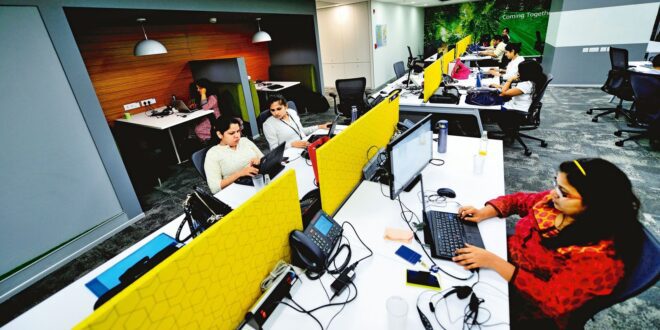rewrite the main part of
From increasing basic customs duty (BCD) on flat panel displays to boost domestic manufacturing, to a new centre of excellence (CoE) on artificial intelligence in education and a ‘fund of funds’ for deep-tech startups, finance minister Nirmala Sitharaman introduced a number of measures to boost localization of India’s electronics manufacturing economy.
Tax tweaks for display manufacturing
Sitharaman tweaked duties on both interactive flat panel displays and open cells of displays—which power consumer LED televisions and their peers—as part of budget 2025.
The BCD on flat panel displays was increased to 20%, which Sitharaman said is “in line with our ‘Make in India’ policy, and to rectify the inverted duty structure.” Open cells used in displays, which are currently not made in India, have been completely exempted from import duty.
Jasbir Singh Gujral, managing director of Syrma SGS, an electronics manufacturing services (EMS) company, said the duty exemption for localizing battery cell and electronics manufacturing “is a step towards enhancing self-reliance and sustainability.”
“While certain duty revisions will require careful industry evaluation, the overall budget signals a strong commitment to long-term industrial growth,” Gujral added.
Avneet Singh Marwah, chief executive officer of contract manufacturer Super Plastronics Pvt Ltd, said the tax tweaks are focused on “benefitting only a select number of manufacturers and brands from China.”
According to Marwah, there are only five open cell manufacturers in the world, and of them, only one is operational in India in China’s TCL. Two others – China’s Skyworth and the US’ Radiant Vision Systems – are in talks to set up facilities here.
“But the duty abolition will only benefit these brands instead of encouraging local brands to participate in this manufacturing endeavour. This is because open cell manufacturing plants can only be set up in partnership with one company at a time—and the reduction of duties will only bring more profits to these select brands rather than truly benefitting India,” Marwah said.
He added that for flat panel displays, “an additional rate of 5% on import of flat panel displays has remained intact, which further adds to the cost of manufacturing of these panels—yet again detrimental for local contract manufacturers.”
Contract manufacturer shares had a mixed reaction to the announcement. The share price of Dixon Technologies, which a senior industry executive said is in talks to set up an open cell display manufacturing facility in India, fell 1.9% at the close on the BSE.
A spokesperson for Dixon Technologies was yet to respond to Mint’s request for comment until press time.
Syrma SGS shares fell 0.6%, recovering after losing 2.8%. However, EMS firms Kaynes Technology rose 2% and Amber Enterprises advanced 1%.
Pankaj Mohindroo, chairman of the India Cellular and Electronics Association, said the tariff exemption for the electronics sector “creates a more competitive cost structure and encourages deeper integration with global value chains… reinforces supply chain resilience and helps India compete effectively in international markets, attracting higher foreign investment.”
₹20,000-crore deep-tech fund
In line with Friday’s Economic Survey 2025, Sitharaman announced a ₹20,000-crore deep-tech ‘fund of funds’ in a bid to increase the flow of capital to deep-tech startups. These startups typically have a long period of product innovation to market and are more in need of large funding.
India’s venture capital ecosystem catering to deep-tech startups is mostly early-stage, limiting the available capital to the industry.
Vishesh Rajaram, managing partner at early-stage deep-tech venture capital firm Speciale Invest, said the fund is good news for India’s startups working on core technical research.
“The fund, coupled with 10,000 fellowships under the PM Research Fellowship Scheme, may transform India’s ability to create revolutionary technologies for global advancement. Together, these initiatives can help India in critical technological domains, fostering self-reliance and innovation on a global scale,” he said.
The fund will be closely linked with the 10,000 research fellowship schemes announced by Sitharaman for the Indian Institutes of Technology (IITs)—wherein startups that begin work and incubate in IITs can follow-through on their innovation to seek funds from the deep-tech fund of funds, post-incubation.
AI skilling: startups and IITs
Sitharaman also announced that a CoE in Artificial Intelligence for education will be set up with a total outlay of ₹500 crore.
Mahesh Makhija, leader, technology at consultancy firm EY India, said that the move was a largely welcome one and in line with expectations.
“This is a pivotal moment as we close the AI talent gap, ensuring that India is not just a consumer of AI—but a creator of cutting-edge solutions. The collaboration between the private sector, premier educational institutions, and research bodies will accelerate the development of AI models tailored for education—bringing personalised learning, automated assessments, and AI-powered tutoring systems into the mainstream fold,” he said.
However, not everyone found the measures to be enough or in line with the projections of the Economic Survey. DD Mishra, vice-president analyst at consultancy firm Gartner, said the AI industry “may have expected more comprehensive measures to drive growth, given AI’s transformative potential.”
“A more substantial investment in AI capability and infrastructure building was expected. To truly leverage AI-led growth, it must be at the core of decision-making and investments. This requires a strategic approach that prioritizes AI development, deployment, and innovation. While the current measures are a step in the right direction, a more concerted effort is needed to propel India’s AI ecosystem forward and ensure the country remains competitive in the global IT landscape,” Mishra added.
Fellowships for technical research initiatives were announced for select IITs. The exact contours of the scheme remain to be announced.
Battery manufacturing
Sitharaman exempted “28 additional capital goods for mobile phone battery manufacturing” from BCD, saying the move “will boost domestic manufacturing of lithium-ion batteries, both for mobile phones and electric vehicles.”
The import subsidies include components used in making printed circuit board assemblies, localization of which has begun only recently. Fully exempted components include camera modules, connectors, USB cables and sensors in a bid to localize more components of the mobile phone manufacturing economy.
The industry has for long demanded moves from the Centre to bring more supply chain partners to India in order to set up a component ecosystem.
Ashok Chandak, chairman of the India Electronics and Semiconductor Association, told Mint last month that localization of the supply chain would need moves to “rationalize” import duties so that more component manufacturers build locally to add value to the domestic ecosystem.
A verdict from the electronics manufacturing ecosystem was awaited until press time.
GCC framework and smart factories
Sitharaman said the Centre is taking measures to boost India’s Industry 4.0 push. It will also establish a framework to guide states in establishing global capability centres (GCCs) in tier-II cities, beyond metropolitan cities.
Last month, Nitin Kunkolienker, chairman of the Manufacturers Association of Information Technology (Mait), told Mint that one of the technology industry’s key asks was to push for the development of “more metropolitan hubs” to attract GCCs to various states.
“Support will be provided to develop domestic manufacturing capacities for our economy’s integration with global supply chains. Sectors (to be offered the Centre’s support) will be identified based on objective criteria. Facilitation groups with participation of senior officers and industry representatives will be formed for select products and supply chains,” Sitharaman said.
The minister said this move will create “huge opportunities related to Industry 4.0, which needs high skills and talent.”
“Our youth have both. The government will support the domestic electronic equipment industry to leverage this opportunity for the benefit of the youth,” Sitharaman said.
Shares of tech services firms declined. Tata Consultancy Services fell 0.86% and Infosys dropped 1.5%, while HCL Technologies was down 1.87%.
Rural internet connectivity
Touching upon broadband connectivity in rural circles, Sitharaman said, “Broadband connectivity will be provided to all government secondary schools and primary health centres in rural areas under the BharatNet project.”
The project is the Centre’s push to bring subsidized internet connectivity to underserved areas.
Bharti Airtel shares fell 0.26%, while telecom infrastructure maker HFCL’s shares were up over 8%.
between 300 to 1000 words in html format and use paragraphs and subheadings with h3 tags.
 Mind Uncharted Explore. Discover. Learn.
Mind Uncharted Explore. Discover. Learn.


